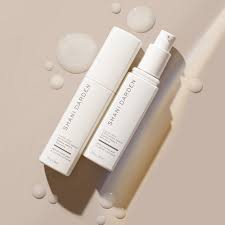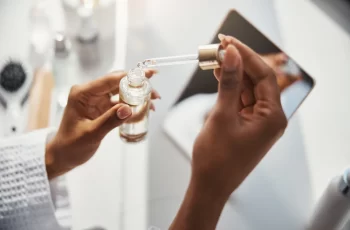Can Lactic Acid Cause Skin Purging?
Have you ever treated yourself to a new skincare product only to find you suffer from a flare-up of blemishes and breakouts, it doesn’t necessarily mean what you first think! Admittedly it could be a result of the ingredients found in the formulation you have tried, especially if it is a rich face cream or containing something you have not introduced to your skincare routine before. This is usually something we would suggest you should stop using all together. The other reason your skin could be breaking out is due to a normal skin reaction called purging, if this is something you have never heard of before you’ve joined us on the perfect day!
In this blog post we are going to be investigating the skin purging that can be caused by AHAs, in particular lactic acid as this it is known as one of the gentlest chemical exfoliants.
What is skin purging?
Often mistaken as a flare-up in breakouts but compared to it being the result of ingredients clogging the pores. Instead, the long-term results of skin purging are increasing the cell turnover by removing the top dead later of the skin making the complexion appear younger, fresh and glowing. The downside to this is the short term accelerated shedding can bring on a lot of blackhead and breakouts, this can often last between 4-6 weeks and requires you to continue using the product to ensure the skin builds its tolerance and reaps the full rewards from the skin performing a purge and removing all traces of unwanted gunk in the lower layers of the pores.
What does skin purging feel like?
You’ll find that purging looks like small, red bumps that can sometimes feel quite painful when touched. You’ll also find more common blemishes appear during purging, such as whiteheads and blackheads which explains how it is very often mistaken for acne breakouts. Considering the red bumps looking and feeling similar to an allergic reaction or irritation we always advise to perform a patch test by applying a 10 pence size amount of the product onto the inside of the forearm and leaving it on the skin for 24 hours. If there are no signs of irritation to the skin after this time, it is a good indication that your skin is happy with the formulation and you can apply it topically with the peace of mind there would be no reactions.
How long does your skin purge before it clears up?
Generally speaking a skin purge can begin to take effect on the skin after 2 weeks when you first start using a new skincare product especially if it is containing an ingredient that can speed the skin cell renewal such as the chemical exfoliants, AHAs, like glycolic acid and lactic acid being the two most popular. Ordinarily the skin can renew its cell cycle every 28 days which is a process that overtime can slow down as we age often resulting in a build-up of cells leaving the complexion looking dry, dull whilst showing signs of premature ageing such as fine lines and wrinkles. You can expect a skin purge to last for as long as 6 weeks, remembering that everyone’s skin is unique making it difficult to determine just how long a purge will last. Many experts and dermatologists say that anything between 4 and 6 weeks is normal but you are still seeing signs for longer you should consult a doctor or dermatologist to discuss what are be done to help calm and reduce the flare-up especially if it is a case of having to adjust the dosage or frequency of applying the product.
What acids cause purging?
There are some acids and certain ingredients that can cause purging such as:
Retinols/retinoids
AHAs such as lactic acid and glycolic acid
BHAs, mainly salicylic acid
All of these ingredients mentioned perform chemical exfoliating meaning they are able to rid the surface of the skin of a build-up of dead skin cells and other traces of dirt and debris that can result in the pores becoming blocked and developing into different breakouts and blemishes. Once the first purge of the skin is subsided you can expect to find the clarity of your skin is improved with the ability for other products to absorb into the skin more effectively.
Can lactic acid damage the skin?
The short answer is no, lactic acid is a popular member of the AHA family and is well known as one of the gentlest used in skincare formulations. It’s molecular size is very large compare to other well-known ingredients, such as glycolic acid and salicylic acid. This also allows this acid to more widely used by all skin types as it can only work on the upper most layers of the skin preventing it from reaching too far into the dermis causing irritation and other reactions. One other benefit of using lactic acid compared to other more potent acids is the fact it is a humectant meaning it is able to draw in moisture from the area surrounding the face and any water from product formulations, locking them into the skin helping it to appear hydrated, less visible signs of ageing with a youthful bounce to the complexion.
How long does lactic acid purging last?
You can expect the purging of the skin after using lactic acid for the first time to last similar time to any other purging, from 4-6 weeks. As previously mentioned, if you are finding the side effects are still very much active and noticeable then it is best to consult with a dermatologist to figure out what would be the best way of tackling this without causing too much dryness and irritation to the skin. You may find that seeing as lactic acid is gentle that purging may not last as long, always remember to take your skin type into consideration when introducing ingredients into your daily routine and if you find your skin to be sensitive and prone to flare-up and inflammations it is best to perform a patch test for 24 hours to avoid any unwanted reactions.
So, there you have a few answers to what purging actually is and how long you can expect to last on the skin. All AHAs vary in potency and can affect the skin in different ways, purging however, is something that will happen and although it may be a nonsense to begin with, in the long run you can expect your skin to look it’s best, feel amazing and reap the rewards of a well thought out daily skincare routine. If you are wanting to find out more about this clever acid you can check out our dedicated blog about lactic acid and its skincare benefits.
Don’t miss out on more skincare tips and expert advice over on our YouTube channel! Come and find us on The Green Sofa by hitting the subscribe button, you won’t regret it!
DQH Knowledge drop: In your 20s, your skin cell turnover decreases. (Cell turnover is a key component in keeping your skin youthful.) You know what else slows down? Your collagen production. Starting in your 20s, collagen decreases by about 1 percent per year. Should you want to prevent fine lines and wrinkles, start by eliminating behaviors that contribute to premature aging. “If it’s bad for you, it’s bad for your skin,” says dermatologist Michel Somenek.
“Cigarette smoking reduces blood flow to the skin and causes premature wrinkling and a dull skin texture. Making the repeated pursed motion to inhale can also cause smoker’s lines. Alcohol and recreational drugs are toxins for the skin that damage its cellular structure and DNA,” Somenek tells us. “The faster you eliminate vices while you are young, the better chance your skin and body have to recuperate.” Also, adopting an anti-aging routine in your 20s is key. After all, the best offense is a good defense. We spoke to Somenek and experts Joshua Ross and Audrey Kunin to find out more.
Keep reading for the best anti-aging products for your 20s, according to skincare professionals.
Sunscreen
“We all know that the sun is the number one cause of skin aging and starting the prevention in your 20s is very important,” Ross says. “The majority of your sun damage won’t start to appear until you’re in your 30s, so don’t wait until you see it surface or you’ll be behind the curve. Stay ahead of it with a good-quality zinc-based sunscreen worn daily.”
Farmacy Green Defense Daily Mineral Sunscreen
An invisible sunscreen with SPF 30, plus botanical extracts meant to protect skin with tons of antioxidants. Bonus: It’s clean and fine to use under makeup.
Bareminerals Complexion Rescue™ Tinted Moisturizer Broad Spectrum SPF 30
Although we recommend you use your SPF and moisturizer separately, we also understand moments when you don’t have time or energy for that extra step. For those times, this bareMinerals moisturizer is a great thing to have on hand.
Vitamin C Serum
“A great introduction to anti-aging is to start with a vitamin C serum in your morning skincare routine,” Ross says. “It’s a powerful antioxidant that will neutralize free radicals and brighten the skin.” He adds that it’s a great way to counteract the effects of the sun’s harmful rays, which, as previously mentioned, are among the biggest causes of premature aging.
Drunk Elephant C-Firma™ Vitamin C Day Serum
The Drunk Elephant C-Firma is a lightweight serum that promises to give skin a glow by combining the brightening powers of vitamin C with ferulic acid, l-ascorbic acid, and vitamin E. The included sodium hyaluronate is meant to replace hydration loss, so you shouldn’t have to deal with any irritation.
Sunday Riley C.E.O. Rapid Flash Brightening Serum
This potent serum is jam-packed with vitamin C (15 percent, to be exact), which means it’s a potential superstar at both brightening skin and dousing it in antioxidants.
Peptides
Using peptides on your skin has many benefits, says Somenek. “The skin barrier is what defends the body against pollution, UV rays, bacteria, and toxins. It can be damaged by several everyday factors. Using topical peptides aids in building a stronger barrier,” he says. “Peptides comprise elastic fibers, which are a type of protein. These fibers help to make skin appear taut and firm. Peptides can also help repair damaged skin, relieve inflammation, and even out skin tone. Some peptides can kill acne-causing bacteria that is common in 20-somethings.”
Kunin agrees, saying, “Peptides are an excellent entry point for supporting collagen.” She recommends looking for face and eye treatments that contain these collagen-boosting powerhouses.
Charlotte Tilbury Magic Eye Rescue Cream
This Charlotte Tilbury super-emollient eye cream has a base of coconut oil and shea butter (read: it’s incredibly hydrating). Botanicals plus peptides are meant to help reduce dark circles and boost collagen, respectively.
This creamy moisturizer serves up potent collagen-boosting peptides and pycnogenol, and antioxidant-rich vitamin C. “Instead of sitting on top of the skin, peptides penetrate the outer layer so they go deep. The ‘signals’ they send tell the cells to produce elastin and collagen, which are needed for youthful-looking skin,” explains Somenek.
At-Home Peel Pads
Remember that skin cell turnover fiasco we talked about earlier? One way to help support it is by exfoliating. “Exfoliation is important to help keep skin fresh and luminous,” Kunin says. She recommends using at-home peel pads as an easy and effective way to exfoliate.
“The goal in your 20s is to fight the slowing pace of cell turnover. It is wise to use products that gently exfoliate, yet still remove oil and other impurities. Products that have Alpha Hydroxy Acids (AHA) or Beta Hydroxy Acids (BHA) are a good choice.”
According to Somenek, you should only exfoliate two to three times a week. “People of all ages are guilty of over-exfoliating and that can be too much of a good thing,” he says.
Dermadoctor Kakadu C Intensive Vitamin C Peel Pad
A few swipes of this Derma Doctor powerful peel pad promise to leave your skin glowing and smooth, thanks to the seven (yes, seven) types of chemical exfoliants, including AHA and BHA. It also contains vitamin C via Kakadu plum extract for added brightening and antioxidant protection.
KEY INGREDIENTS Kakadu plum extract is sourced from the Kakadu plum, a fruit grown in northern Australia. It contains vitamin C, which restores the skin’s natural barrier, increases collagen production, and soothes irritation.
Dr. Dennis Gross Skincare Alpha Beta® Universal Daily Peel Pads
These are the gold standard of peel pads, with a cult following and over 900 five-star reviews on Sephora. They’re easy to use and contain a blend of anti-aging exfoliating acids.
Emollient Night Cream
“In your 20s, you need to start upping the hydration in your skincare routine. You may have been cautious of over-moisturizing because of acne in your teens, but as you enter your 20s, your skin transitions and becomes drier,” Ross says. “I recommend an emollient night cream added into your evening skincare regimen.”
“Twenty-somethings need to make sure that they are not using creams that will clog their pores and cause excess oil production,” says Somenek. Opt for non-comedogenic products.
Cerave Skin Renewing Night Cream
One great choice is the CeraVe Skin Renewing Night Cream, which is a non-comedogenic night cream that leaves skin soft and glowy. It combines the moisturizing powers of ceramides and hyaluronic acid.
RoC Retinol Correxion Max Hydration Creme
“The best night cream ingredients contain retinol, benzoyl peroxide, and/or salicylic acid or hyaluronic acid. The goal is to moisturize, yet remove excess oil,” says Somenek. This Roc Retinol Correxion cream fits the bill as it contains both hyaluronic acid and retinol so it promises to moisturize while also being non-comedogenic.



